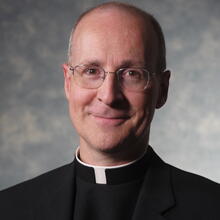When A Practicing Jesuit Loves a 20 yrs+ Gay Relationship of 2 Married Men
Since the first edition of my book Building a Bridge, about L.G.B.T. Catholics, was published last June, I have been privileged to speak at many parishes, colleges, retreat houses and conferences. At each venue, L.G.B.T. people and their families and friends have shared their experiences with me. Some were so powerful that they have become almost like parables for me. In the revised and expanded edition of the book, published this month, I share six of these stories.
In his now-famous definition, the biblical scholar C. H. Dodd said that a parable was a story designed to “tease the mind into active thought.” Stories have the capacity to open our minds in a way definitions cannot. This is one reason Jesus used parables extensively in his public ministry, as a way of inviting his listeners to see life from a new perspective.
I hope these few stories about L.G.B.T. Catholics tease your mind into active thought. Stories have the capacity to open our minds in a way definitions cannot.
1. One of my oldest friends is a gay man named Mark, who was once a member of a Catholic religious order. About 20 years ago, after Mark left the order, he came out as a gay man and began living with his partner, with whom he is now legally married. His partner has a serious, long-term illness, and Mark has cared for him for many years with great devotion and loving-kindness.
What can we learn from Mark about love?
2. An elderly man told me that his grandson recently came out to him as a gay man. I asked what he had said in response. He said that he had suspected for some time that his grandson was gay, and so when his grandson sat down to tell him, before a word was even on the young man’s lips, the grandfather said, “I love you no matter what you’re about to say.”
What can we learn from this grandfather about compassion?
3. After a talk I gave at a Catholic college in Philadelphia, a young man told me that the first person to whom he came out as a gay man was a Catholic priest. During a high school retreat, he decided to publicly acknowledge his homosexuality, but he was so nervous that he was “literally shaking.” The first thing the priest said to him was “Jesus loves you. And your church accepts you.” The young man told me, “It saved my life.”
What can we learn from this priest about acceptance?
“I have a grandchild who is transgender, and I love her so much. All I want is for her to feel welcome in the church.”
4. A woman in her 80s, with snowy white hair and apple cheeks, came to my book-signing table after a talk I had given in Connecticut and said, “Father, I have something to tell you.” The focus of the talk had been on Jesus, not on L.G.B.T. issues specifically. I thought she might share an insight about Jesus or tell me that she had been on a pilgrimage to the Holy Land. Instead she said, “Father, I have a grandchild who is transgender, and I love her so much. All I want is for her to feel welcome in the church.”
What can we learn from this grandmother about faith?
5. At a parish in Boston, a gay man and a lesbian woman were invited to respond to my lecture on L.G.B.T. Catholics, in the spirit of fostering a real conversation. In her response, the lesbian woman, named Maggie, chose to discuss a reflection question that appears at the end of my book: “When you think about your sexual orientation or gender identity, what word do you use?” My intention was to invite readers to reflect on biblical passages about names and naming and encourage them to “name” their sexuality.
So I had expected words like “gay,” “lesbian” and “bisexual.” But that night in the parish, Maggie said that when she read that question and thought of her sexuality, she thought of the word “joy.” It was such a surprise!
What can we learn from Maggie about sexuality?
What can we learn from these stories? What does God want to teach us?
6. And perhaps the biggest surprise: On that same evening in Boston, a couple stayed afterward to have their book signed. One was a transgender woman—that is, a woman who had begun her life as a man. The other was a cisgender woman—that is, someone born a woman who is still a woman. (I have tried to be mindful of contemporary terminology, though I recognize that these terms get dated quickly.)
The cisgender woman told me that the two had been married for many years, which confused me, since same-sex marriage had not been legal for that long in Massachusetts. She sensed my confusion, smiled and said, “I married her when she was still a man.”
I was reduced to stunned silence. Here was an apparently straight woman who had married a straight man who was now a woman. How had she done it? “Love is love,” she said.
Here is a marriage that almost every church official would probably consider “irregular,” to use the official ecclesiastical term. Yet it was a model of faithfulness. Even after one partner had “transitioned,” the marriage was still intact.
What can we learn from them about fidelity?
Overall, what can we learn from these stories? Where are we invited to see life in a new way? What does God want to teach us?


Comments